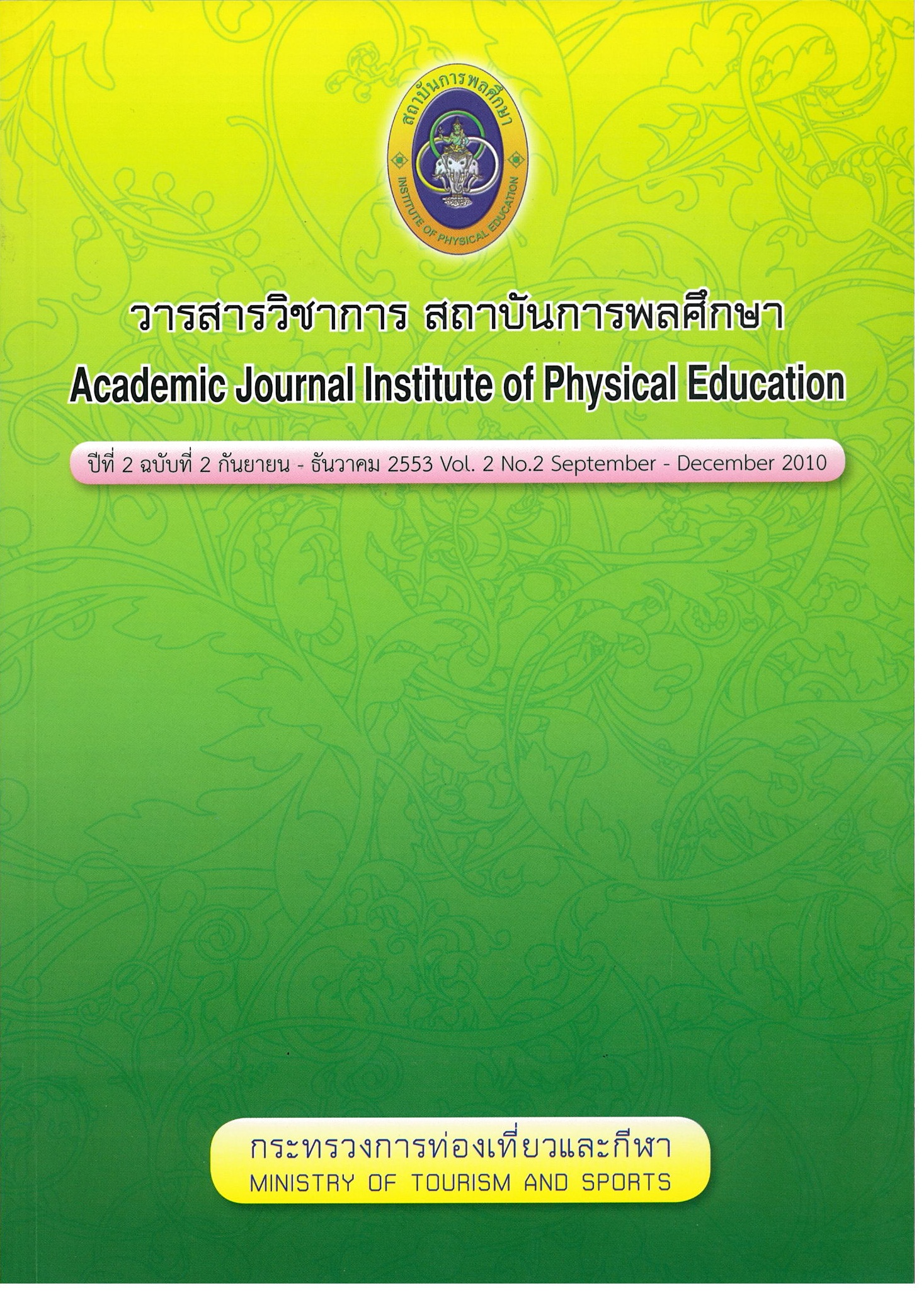ธาราบําบัดสําหรับคนทั่วไปและนักกีฬา
Main Article Content
Abstract
ธาราบําบัด (Hydrotherapy) คือการรักษาด้วยน้ําและฟื้นฟูสุขภาพทั้งร่างกายและจิตใจรวมทั้ง ป้องกันและส่งเสริมสุขภาพร่างกายผู้ป่วย บุคคลทั่วไป และนักกีฬา ธาราบําบัดยังรวมถึงการใช้น้ําร้อน น้ําเย็น น้ําแข็ง หรือไอน้ํา อ่างน้ําร้อน อบไอน้ํา ฝักบัวชนิตรูน้ําเล็กสําหรับฉีด ประคบความเย็นหรือร้อน ธาราบําบัด เป็นกิจกรรมที่สามารถทําได้หลายรูปแบบเพื่อความผ่อนคลายและบําบัดโรคมีมาตั้งแต่สมัยโบราณ ผลจาก การศึกษาแสดงหลักฐานให้เห็นว่าธาราบําบัดมีประโยชน์ในการที่จะนํามาใช้บําบัดรักษาและฟื้นฟูผู้ป่วยโรค ต่างๆ รวมทั้งคนทั่วไปและนักกีฬาให้มีสุขภาพกายและส่งผลต่อจิตใจให้ดีขึ้นได้โดยการใช้น้ําเป็นสื่อ น้ํามี คุณสมบัติที่สําคัญที่จะทําให้ร่างกายตอบสนองแล้วส่งผลต่อการบําบัดรักษา คุณลักษณะของน้ําที่สําคัญ และเกี่ยวข้องกับธาราบําบัดโดยตรงประกอบไปด้วย ความหนาแน่นของน้ํา (Density) ความถ่วงจําเพาะ (Specific gravity) แรงดันน้ํา (Hydrostatic pressure) และแรงพยุงของน้ําทําให้วัตถุลอย (Buoyancy)
ผลของธาราบําบัดที่เกิดต่อร่างกายพบได้จากการสังเกต การลองผิดลองถูกในสมัยโบราณและยืนยัน ผลที่เกิดขึ้นผ่านวิธีการทางวิทยาศาสตร์จนพบว่าการที่ร่างกายลงแช่ในน้ําในบางส่วนหรือลงแช่ทั้งตัวมีผลต่อ การเปลี่ยนแปลงระบบการทํางานของร่างกายซึ่งทางการแพทย์ได้ทราบผลเหล่านี้และเป็นที่มาของศาสตร์ ในการใช้น้ําบําบัดโรค (Medical hydrology) ซึ่งผลของธาราบําบัดจะมีผลต่อระบบ ระบบหายใจและปอด ระบบกล้ามเนื้อ ระบบไหลเวียนโลหิต ระบบประสาทรับความรู้สึกร้อน เย็น สัมผัส และความเจ็บปวด ธาราบําบัดยังสามารถนําไปใช้ได้กับบุคคลทั่วไปโดยเฉพาะผู้ที่เหน็ดเหนื่อยจากการทํางานและมีความเครียด ซึ่งทําให้มีอาการปวดหัว รู้สึกอ่อนล้า การแช่น้ําจะช่วยทําให้ระบบไหลเวียนโลหิตไหลเวียนได้ดีขึ้น และแรงดันน้ํา ช่วยผ่อนคลายกล้ามเนื้อเปรียบเสมือนการนวดทําให้อาการปวดเมื่อยกล้ามเนื้อลดลง ทําให้ ร่างกายรู้สึกกระปรี้กระเปร่า ส่วนในนักกีฬา คุณสมบัติของน้ําจะมีส่วนช่วยในด้านการขนส่งของเสียจาก ขบวนการเผาผลาญทางเคมี (Metabolic waste) ในร่างกายถูกขจัดออกไปได้ดีขึ้นส่งผลให้นักกีฬาฟื้นตัว ได้ดีและรวดเร็วยิ่งขึ้น
Article Details
The published article is a copyright of the Academic Journal of Thailand National Sports University. The passage appeared in each article in this academic journal is a perspective of each author which is not related to the journal. Each author is required to be responsible for all components of his/her own article. If there are any mistakes, each author must be responsible for those mistakes on his/her own.
References
Andrew, C. J., & Bruce, B. E. (2003). Comprehensive Aquatic Therapy. 2nd ed. Pennsylvania: Butterworth Heinemann.
Bender, T., & Karag?lle, Z. (2004). Hydrotherapy, Balneotherapy, and Spa Treatment in Pain Management. Rheumatoid International. Retrieved January 21, 2009, from http://springerlink.metapress.com.
Chaplin, M. (2005). Water Structure and Behaviour. Retrieved January 21, 2009, from http//www.lsbu.ac.uk/water/index.html.
Choukroun, M. L., & Varene, P. (1990, January). Adjustments in Oxygen Transport during Head-out Immersion in Water at Different Temperatures. Journal of Applied Physiology. (68): 1475-1480.
Clark, M. G., & Rattigan, S. (1998, September). Vascular Control of Nutrient Delivery by Flow Redistribution within Muscle; Implications of Exercise and Post-Exercise Muscle Metabolism. International Journal of Sports Medicine. (19): 391-400.
Collins, M. A., & Cureton, K. J. (1989, February). Relation of Plasma Volume Change to Intensity of Weight Lifting. Medicine and Science in Sports Exercise. 21(2): 178-85.
Gabrielsen, A., & Johansen, L. B. (1993, June). Central Cardiovascular Pressures during Graded Water Immersion in Humans. Journal of Applied Physiology. (75): 581-585.
Gabrielsen, A. (2000, August). Arterial Pulse Pressure and Vasopressin Release During Graded Water Immersion in Humans. American Journal of Physiology. 27(8): 1583-1588.
Johansen, L. B., & Jensen, T. U. S. (1997, March). Contribution of Abdomen and Legs to Central Blood Volume Expansion in Humans during Immersion. Journal of Applied Physiology. 83(3): 695-901.
Lan, W. M., et al. (2006, September). Physiological Response to Water Immersion a Method for Sport Recovery. Journal of Sports Medicine. 36(9): 747-765.
McArdle, W. D., Katch, F. 1., & Katch, V. L. (1991). Functional Capacity of The Cardiovascular System in Exercise Physiology. Malvern Penn: Lea & Febiger.
Mangelsdorff, G. (2001). Strength of Inspiratory Muscles in Chronic Heart Failure and Chronic Pulmonary Obstructive Disease in Spanish. Journal of Medicine Chile. (129): 51-59.
Miles, D. S., Sawka, M. N., & Glaser, R. M. (1983, October). Palsma Volume Shift during Progressive Arm and Leg exercise. Journal of Applied Physiology. (54): 491-503.
Romer, M. L., & Jones, D. A. (2002, April). Inspiratory Muscle Fatigue in Trained Cyclists: Effects of Inspiratory Muscle Training. Medicine and Science in Sports and Exercise. (34): 785-792.
Romer, M. L., & Jones, D. A. (2002). Effects of Inspiratory Muscle Training upon Recovery Time during High Intensity, Repetitive Sprint Activity. International Journal of Sports Medicine. (23): 353-360.
Somers, L., & Davis, J. C. (1990). Diving Medicine. 2nd ed. Philadelphia: Saunders.
Tajima, F. (1988, February). Renal and Endocrine Responses in The Elderly During Head-out Water Immersion. American Journal of Physiology. (2): 977-983.
Tei, C., & Tanaka, N. (1995, November). Treatment of Chronic Congestive Heart Failure to Improve Their Quality of Life-Clinical Study of Thermal Vasodilation Therapy in Japanese. Nippon Naika Gakkai Zasshi. (84): 1475-1482.
Taylor, N. A., & Morrison, J. B. (1999, May). Static Respiratory Muscle Work during Immersion with Positive and Negative Respiratory Loading. Journal of Applied Physiology. (87): 1397-1403.
Wilder, R. P., & Brennan, D. K. (1993, January). Physiological Responses to Deep Water Running in Athletes. Sports Medicine. (16): 374-380.


